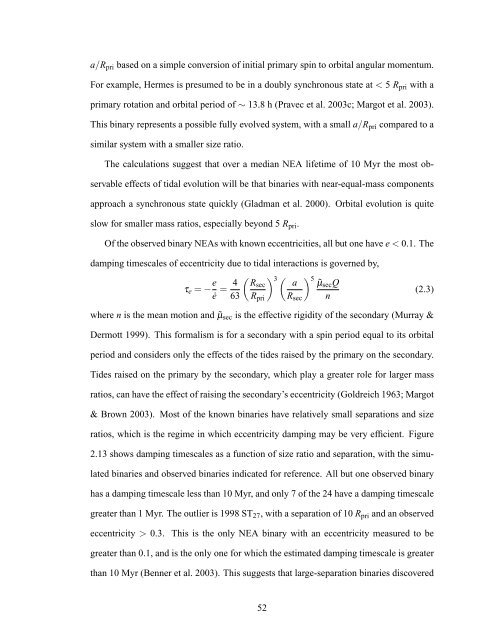Forming Binary Near-Earth Asteroids From Tidal Disruptions
Forming Binary Near-Earth Asteroids From Tidal Disruptions
Forming Binary Near-Earth Asteroids From Tidal Disruptions
You also want an ePaper? Increase the reach of your titles
YUMPU automatically turns print PDFs into web optimized ePapers that Google loves.
a/R pri based on a simple conversion of initial primary spin to orbital angular momentum.For example, Hermes is presumed to be in a doubly synchronous state at < 5 R pri with aprimary rotation and orbital period of ∼ 13.8 h (Pravec et al. 2003c; Margot et al. 2003).This binary represents a possible fully evolved system, with a small a/R pri compared to asimilar system with a smaller size ratio.The calculations suggest that over a median NEA lifetime of 10 Myr the most observableeffects of tidal evolution will be that binaries with near-equal-mass componentsapproach a synchronous state quickly (Gladman et al. 2000). Orbital evolution is quiteslow for smaller mass ratios, especially beyond 5 R pri .Of the observed binary NEAs with known eccentricities, all but one have e < 0.1. Thedamping timescales of eccentricity due to tidal interactions is governed by,τ e = − ė e = 463( ) 3 ( )5Rsec a ˜µ sec QR pri R sec n(2.3)where n is the mean motion and ˜µ sec is the effective rigidity of the secondary (Murray &Dermott 1999). This formalism is for a secondary with a spin period equal to its orbitalperiod and considers only the effects of the tides raised by the primary on the secondary.Tides raised on the primary by the secondary, which play a greater role for larger massratios, can have the effect of raising the secondary’s eccentricity (Goldreich 1963; Margot& Brown 2003). Most of the known binaries have relatively small separations and sizeratios, which is the regime in which eccentricity damping may be very efficient. Figure2.13 shows damping timescales as a function of size ratio and separation, with the simulatedbinaries and observed binaries indicated for reference. All but one observed binaryhas a damping timescale less than 10 Myr, and only 7 of the 24 have a damping timescalegreater than 1 Myr. The outlier is 1998 ST 27 , with a separation of 10 R pri and an observedeccentricity > 0.3. This is the only NEA binary with an eccentricity measured to begreater than 0.1, and is the only one for which the estimated damping timescale is greaterthan 10 Myr (Benner et al. 2003). This suggests that large-separation binaries discovered52












